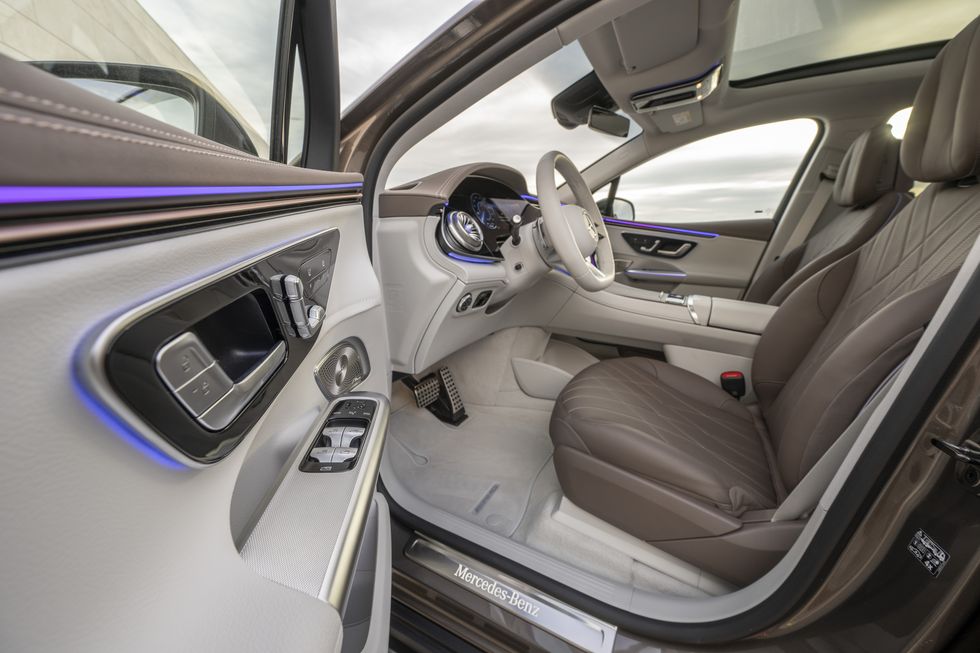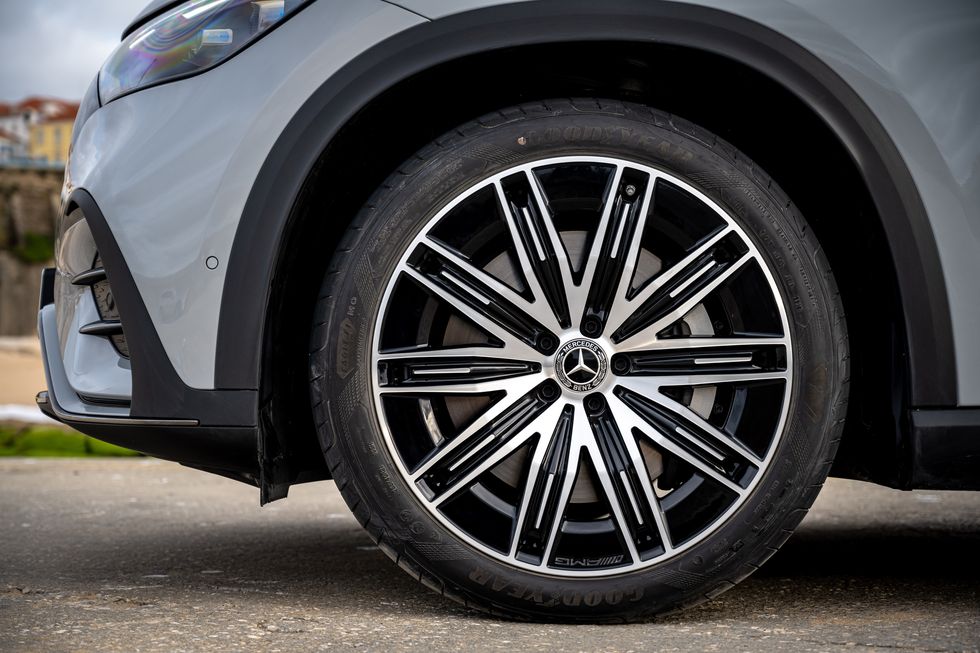2023 Mercedes-Benz EQE SUV Dials Back the Weirdness

Should EVs make a statement? Or should they blend in with the gas-powered masses? That’s the major question facing designers in the tectonic shift to electric propulsion. After watching Tesla sprint ahead as the tech-forward luxury offering, Mercedes-Benz burst out of the gate with its EQS sedan, an S-class-level electric vehicle on a dedicated platform with a look that pushed the envelope. The next-up mid-size EQE sedan followed suit. The SUV models, first the EQS SUV and now the EQE SUV, adopt a more familiar form. Playing in the heart of the market, the EQE SUV tries harder to not alienate the great swaths of buyers that presumably will soon enter this segment.
The EQE SUV doesn’t have the odd, taffy-stretched form of the sedans, but it is lower (by 4.4 inches) and more rounded than its conventionally powered counterpart, the GLE. The EQE SUV is also 2.4 inches trimmer in length but nearly identical in width. The EQE SUV’s egglike form, plus its smooth underbody, contributes to a slippery 0.25 drag coefficient. But it’s no weirder looking than its BMW counterpart, the iX, which takes an alternate tack on the neo-SUV idea. True aesthetes might be drawn instead to the conventionally shaped Audi e-tron or the edgy-but-still-approachable Cadillac Lyriq.
The EQE SUV is the fourth model to use Benz’s dedicated EV platform, and being fourth has its advantages. Specifically, the EQE SUV introduces two innovations. All-wheel-drive models have the ability to power down the front motor (except in Sport mode), which Mercedes claims results in a 6 percent improvement in range. Additionally, the climate control system uses a heat pump to more efficiently heat the cabin. (We’re told both features will soon spread to the other EQ models.)
Inside, there’s greater commonality with the EQE sedan. The entire front passenger compartment is similarly configured, and the upper trims have the same ritzy details. The EQE’s dash dips down at the center to meet the tallish center console, a less spacious-feeling arrangement than you’ll find in EVs such as the iX and the Genesis GV60 that play up the flat floor of an EV by offering open space at the front of the console. However, the Mercedes does provide a large bay underneath the floating console, and the top part has a covered bin with space for your phone and the requisite two cupholders.
Mercedes-Benz
Some of the EQE SUV models we drove had a freestanding central screen and a separate digital instrument cluster; others were equipped with the brand’s dash-spanning Hyperscreen (even though that option won’t be available in U.S. cars until next year). In addition to its wow factor, the Hyperscreen adds a display for the front passenger that offers redundant controls for much of the infotainment, as well as the ability to stream video or games—or it can just display a picture of your dog. With or without the Hyperscreen, there’s a digital instrument cluster and a large central touchscreen. The former has a variety of display options, and the latter boasts relatively easy access to major functions. When using navigation, for instance, the display keeps open small submenus for other functions, including audio, phone, and major climate controls. Still, we bemoan the lack of any non-touch switchgear, with the worst offenders being the touch slider for audio volume and the tiny four-way touchpads on the steering wheel. Such are the travails of modernity.
Despite a wheelbase that’s 3.5 inches shorter than the EQE sedan’s, rear-seat space is generous. Occupants find plenty of legroom and knee clearance, and the flat floor makes the middle position tenable. The EQE’s rounded form cuts into cargo space, however, as its 14 cubic feet behind the rear seats is well short of the GLE’s 33 cubes. Seats folded, the total volume is 55 cubic feet. And whereas the GLE wedges in an optional third-row seat, the EQE SUV is strictly a five-seater.
As pleasant as the EQE SUV cabin is to look at, we wish it were easier to look out of. The brow over the dashboard makes for a shallow windshield, and the stocky A-pillars stretch forward into the field of view. We had to raise the driver’s seat to get a decent view out, but in tight confines, it’s tough to judge where the bodywork ends.
The SUV largely mirrors the EQE sedan’s motive offerings, though here with a bit more torque. There are three powertrains: the single-motor, rear-wheel-drive 350+ and the dual-motor, all-wheel-drive 350 4Matic and 500 4Matic. Both 350s have 288 horsepower—fewer ponies than in mid-size electrics from Audi, BMW, Cadillac, or Genesis. Torque output is more respectable, with the single-motor powertrain spinning out 417 pound-feet and the dual-motor 564 pound-feet. The high-zoot EQE500 pumps out 402 horses and 633 pound-feet, which puts it closer to the BMW iX xDrive50 (516 horsepower, 564 pound-feet). Presumably, the upcoming AMG version of the EQE will have the beans to face off against the 610-hp iX M60.

Mercedes-Benz
We first drove the 350+, and while it’s perky enough in town, acceleration at higher speeds is rather languid, particularly for an EV. Switching next to the 350 4Matic, one can definitely feel the dual-motor version’s extra torque, which wakes up response when passing on two-lanes or merging onto a freeway. Step up to the EQE500, and you get the kind of scenery-blurring acceleration that EVs are becoming known for. But even the EQE500 is still likely to fall well shy of the sprinting capabilities of the Genesis GV60 Performance (which hit 60 mph in 3.7 seconds in our testing) or the BMW iX xDrive50 (which did so in 4.0). For blame, we might look to the EQE500’s curb weight, which Mercedes pins at 5665 pounds (even the lightest EQE350+ version is a claimed 5300 pounds). But the iX, the e-tron, and the Lyriq all spent just as much time bellying up to the buffet, as all three pack more than 5500 pounds.
Mercedes offers four different Soundscapes, oddball soundtracks that we were only too happy to switch off. Doing so does not totally extinguish the whirr from the electric motors, however. At highway speeds, the car is quiet; wind rustle is all but absent, leaving only tire noise to be heard.
The EQE350+ we drove was riding on steel springs and passive dampers, which is the standard setup. Aided by 19-inch wheels (the smallest available), that suspension did a reasonable job coping with the beat-up cobblestone streets in the old section of Lisbon, Portugal, where our drive took place. The 350+ exhibited some side-to-side body motions over pavement disturbances at higher speeds. The EQE350 and EQE500 4Matics we drove had the optional air springs and adaptive dampers. That setup kept a tighter rein on body motions, although it suffered a bit more impact harshness, likely owing to the larger rolling stock on those two cars. We did not discern an appreciable difference between the Sport and Comfort modes.
In all three cars, the steering has a reasonable degree of effort, but it doesn’t build as cornering forces increase and ends up just feeling inert. Rear-axle steering, which turns the rear wheels up to 10.0 degrees, is standard on the EQE500. The system is clearly evident when you fully crank the wheel in low-speed maneuvers, and we were surprised at the EQE’s ability to bang a U-turn on a narrow two-lane road.
The EQE offers four levels of brake-energy recuperation: Strong, Normal, No, and Intelligent. Normal approximates the experience of driving an internal-combustion car, while No recuperation enables a sailing mode. Intelligent is a little weird to get used to because the degree to which the car slows when you let off the accelerator is different all the time. Sometimes it varies based on whether the system detects a slower vehicle ahead, and other times it reacts to information from the navigation system (whether you’re entering a reduced-speed zone or approaching a stop sign, say). If the car ahead stops, Intelligent mode can work like one-pedal driving, stopping the EQE. But true one-pedal fans might prefer Strong recuperation mode, which always slows the car aggressively when the accelerator is released, even if it doesn’t quite bring the vehicle to a full stop.

Mercedes-Benz
More aggressive regen modes hold extra appeal here because they minimize the interaction with the brake pedal. Like its sibling EQ models, the EQE SUV’s brake modulation feels unnatural, with the initial wooden response becoming suddenly grabby as you apply more pressure. The result is that smooth stops can be a challenge.
As with other EQ models, the maximum recharge rate is 170 kW; at max draw, Mercedes estimates 32 minutes for a recharge of 10 to 80 percent. On a Level 2 source, replenishing the battery from 10 to 100 percent happens in 9.5 hours. Customers get two years of free 30-minute fast-charging sessions at Electrify America stations, and, looking ahead, Mercedes has announced a plan to build its own fast-charging network, à la Tesla.
All EQE SUVs use the same 90.6-kW battery pack. It provides EPA range estimates of 279 miles for the single-motor EQE350+ and 253 miles for the EQE350 4Matic, with the EQE500 4Matic good for 269 miles. Those numbers are credible but not class-leading. They land the Mercedes comfortably ahead of the e-tron, but behind the Lyriq and iX and well aft of the still-class-leading Tesla Model X.
Pricing for the EQE SUV unsurprisingly starts just under the magic $80,000 mark (the vehicle’s Alabama assembly site and U.S. battery factory being the other key factors in securing federal tax-credit eligibility). What is unusual is that the single- and dual-motor EQE350 models have the same $79,050 ask. It’s hard to imagine many buyers picking the 350+ over the 350 4Matic, even with the rear-drive version’s slight advantage in range. The EQE500 4Matic, meanwhile, opens at $90,650. All three are offered in Premium, Exclusive, and Pinnacle trims; the EQE500 in Pinnacle form stretches the price tag to $96,350.
Rich pricing is pretty characteristic of Mercedes-Benz—for some, it’s part of the brand’s appeal. At least with the EQE SUV, anyone who wants to flash around town in an electric Benz won’t have to get past a weird exterior shape to do so.
Arrow pointing downArrow pointing down
Specifications
Specifications
2023 Mercedes-Benz EQE SUV
Vehicle Type: mid- or front- and mid-motor, rear- or all-wheel-drive, 5-passenger, 4-door wagon
PRICE
Base: EQE350+, $79,050; EQE350 4Matic, $79,050; EQE500 4Matic, $90,650
POWERTRAIN
Motors: permanent-magnet synchronous AC
Power: 288 or 402 hp
Torque: 417, 564, or 633 lb-ft
Battery Pack: liquid-cooled lithium-ion, 90.6 kWh
Onboard Charger: 9.6 kW
Peak DC Fast-Charge Rate: 170 kW
Transmissions: direct-drive
DIMENSIONS
Wheelbase: 119.3 in
Length: 191.5 in
Width: 76.4 in
Height: 66.3 in
Cargo Volume, Behind F/R: 55/14 ft3
Curb Weight (C/D est): 5350–5750 lb
PERFORMANCE (C/D EST)
60 mph: 4.0–5.6 sec
1/4-Mile: 12.5–14.1 sec
Top Speed: 130 mph
EPA FUEL ECONOMY (C/D EST)
Combined/City/Highway: 82–90/85–92/80–88 MPGe
Range: 253–279 mi

Deputy Editor, Reviews and Features
Joe Lorio has been obsessed with cars since his Matchbox days, and he got his first subscription to Car and Driver at age 11. Joe started his career at Automobile Magazine under David E. Davis Jr., and his work has also appeared on websites including Amazon Autos, Autoblog, AutoTrader, Hagerty, Hemmings, KBB, and TrueCar.



